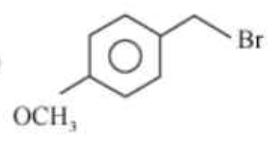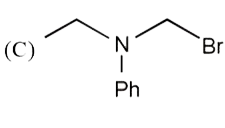Ease of ionization to produce carbocation and bromide ion under the treatment of Ag⊕will be maximum in whichof the following compounds ?




The correct Answer is:A
To determine which compound will have the maximum ease of ionization to produce a carbocation and bromide ion under the treatment of Ag⊕, we need to analyze the stability of the carbocations formed from the given compounds. Here’s a step-by-step solution:
Step 1: Identify the Compounds
List the four compounds provided in the question. Without the specific compounds mentioned, we will refer to them as Compound A, Compound B, Compound C, and Compound D.
Step 2: Understand Ionization Process
When a compound reacts with Ag⊕, it can lead to the formation of a carbocation and a bromide ion. The reaction can be represented as follows:
\( \text{R-Br} + \text{Ag}^+ \rightarrow \text{R}^+ + \text{Br}^- + \text{AgBr} \)
Here, R represents the alkyl or aryl group.
Step 3: Analyze Carbocation Stability
The stability of the carbocation (R+) is crucial for the ease of ionization. The factors affecting carbocation stability include:
- Resonance: Carbocations that can delocalize their positive charge through resonance are more stable.
- Inductive Effect: Alkyl groups can donate electron density through the +I effect, stabilizing the positive charge.
- Aromaticity: Carbocations that are part of an aromatic system are highly stable.
Step 4: Evaluate Each Compound
For each compound, assess the potential for resonance, inductive effects, and aromaticity:
- Compound A: Check if it is cyclic and if it can exhibit resonance. Count the number of pi electrons to determine if it is aromatic.
- Compound B: Similar analysis as Compound A.
- Compound C: Check for resonance and inductive effects.
- Compound D: Evaluate for stability factors.
Step 5: Determine the Most Stable Carbocation
Based on the analysis:
- The compound that can form a carbocation with the highest stability (due to resonance or aromaticity) will have the maximum ease of ionization.
- If one of the compounds is aromatic, it will generally be more stable than non-aromatic compounds.
Conclusion
The compound that exhibits the highest stability for its carbocation, likely due to resonance or aromaticity, will be the one that undergoes ionization most easily in the presence of Ag⊕.
Answer
Thus, the answer to the question is Compound A (or whichever compound is determined to be the most stable based on the analysis).
---
List the four compounds provided in the question. Without the specific compounds mentioned, we will refer to them as Compound A, Compound B, Compound C, and Compound D.
When a compound reacts with Ag⊕, it can lead to the formation of a carbocation and a bromide ion. The reaction can be represented as follows:
\( \text{R-Br} + \text{Ag}^+ \rightarrow \text{R}^+ + \text{Br}^- + \text{AgBr} \)
Here, R represents the alkyl or aryl group.
The stability of the carbocation (R+) is crucial for the ease of ionization. The factors affecting carbocation stability include:
- Resonance: Carbocations that can delocalize their positive charge through resonance are more stable.
- Inductive Effect: Alkyl groups can donate electron density through the +I effect, stabilizing the positive charge.
- Aromaticity: Carbocations that are part of an aromatic system are highly stable.
For each compound, assess the potential for resonance, inductive effects, and aromaticity:
- Compound A: Check if it is cyclic and if it can exhibit resonance. Count the number of pi electrons to determine if it is aromatic.
- Compound B: Similar analysis as Compound A.
- Compound C: Check for resonance and inductive effects.
- Compound D: Evaluate for stability factors.
Based on the analysis:
- The compound that can form a carbocation with the highest stability (due to resonance or aromaticity) will have the maximum ease of ionization.
- If one of the compounds is aromatic, it will generally be more stable than non-aromatic compounds.
The compound that exhibits the highest stability for its carbocation, likely due to resonance or aromaticity, will be the one that undergoes ionization most easily in the presence of Ag⊕.
Thus, the answer to the question is Compound A (or whichever compound is determined to be the most stable based on the analysis).
Topper's Solved these Questions
- GOCBook:MOTIONChapter:GOCExercise:Exercise - 3
Explore 44 Videos
- GOCBook:MOTIONChapter:GOCExercise:Exercise - 4 Level - I
Explore 13 Videos
- GOCBook:MOTIONChapter:GOCExercise:Exercise - 2 (Level - I)
Explore 31 Videos
- GASEOUS STATE Book:MOTIONChapter:GASEOUS STATE Exercise:EXERCISE-4( LEVEL-II)
Explore 19 Videos
- GRIGNARD REAGENTBook:MOTIONChapter:GRIGNARD REAGENTExercise:EXERCISE-2
Explore 16 Videos
Similar Questions
Ease of ionization to produce carbocation and bromide ion under the statement of Ag+ will be maximum in which of the following compounds?




View SolutionWrite the structures of the products obtained from the reactions of phenylmagnesium bromide (excess) with each of the following compounds. Assume that the reactions are worked up by the addition of dilute aqueous acid.
Et−O−O∣∣C−O−Et
View Solution
Knowledge Check
Ease of ionization to produce carbocation and bromide ion under the treatment of Ag⊕ will be maximum in which of the following compounds?
A B
B C
C D
D
The bond length of the S-O bond is maximum in which of the following compounds?
ASOCl2BSOBr2CSOF2DAll have same lengthThe bond length of the S-O bond is maximum in which of the following compounds?
ASOCl2BSOBr2CSOF2DAll have same length
Write the structures of the products obtained from the reactions of phenylmagnesium bromide (excess) with each of the following compounds. Assume that the reactions are worked up by the addition of dilute aqueous acid.
CH3−O∣∣C−O−Et
View SolutionThe bond length of the S - O bond is maximum in which of the following compound?
SOBr2,SOCl2,SOF2
View SolutionThe bond length of the S - O bond is maximum in which of the following compound?
SOBr2,SOCl2,SOF2
View SolutionFor the percipitation reaction of Ag⊕ ions with NaCI, which of the following statements is true?
View SolutionAniline on treatment with sodium nitrite and HCI at 0∘C produces which of the following compound?
View Solution

